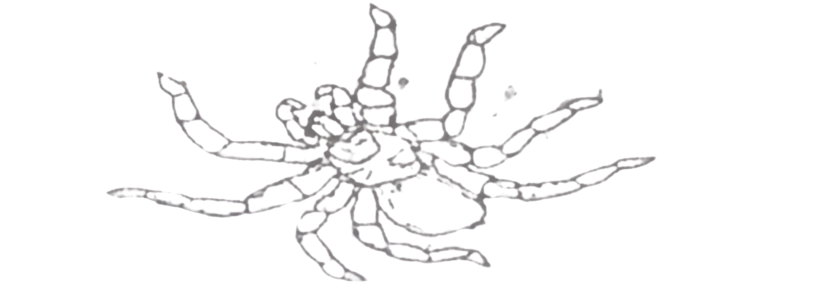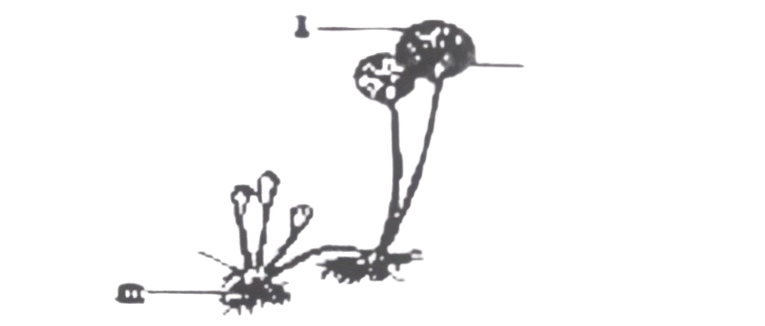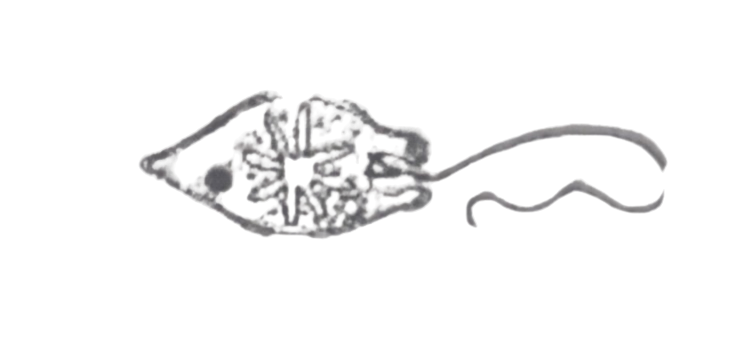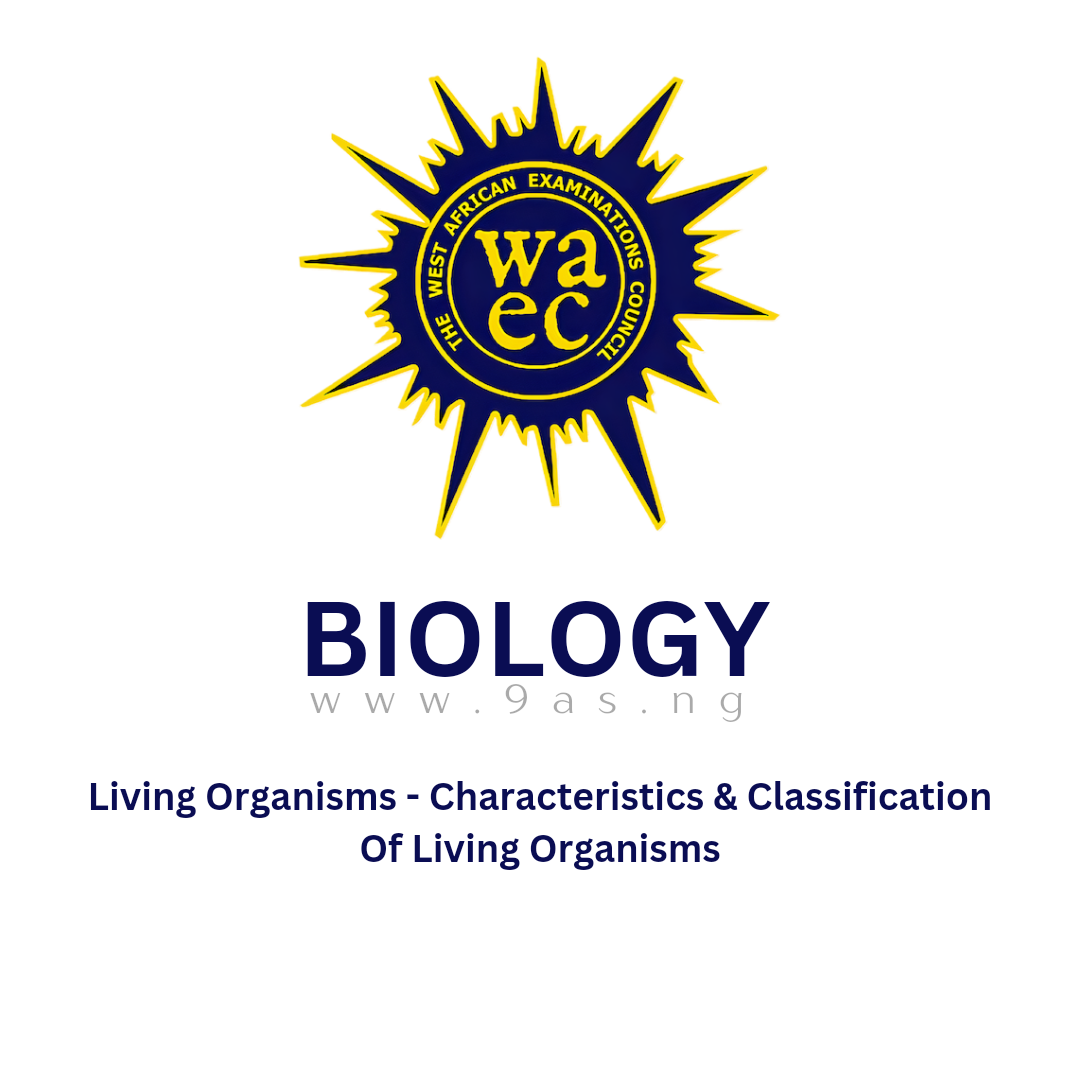Summary of the Topic:
This topic covers two key biology areas often tested in WAEC:
- Characteristics of Living Organisms – What defines life.
- Classification of Living Organisms – How living things are grouped based on features.
Key Concepts Explained:
Characteristics of Living Organisms:
Living things share common traits often remembered with the acronym MR NIGER D:
- Movement
- Respiration
- Nutrition
- Irritability (response to stimuli)
- Growth
- Excretion
- Reproduction
- Death
These features distinguish living organisms from non-living things.
Classification of Living Organisms:
Organisms are classified based on:
- Structure
- Cell type (prokaryotic or eukaryotic)
- Mode of nutrition (autotrophs or heterotrophs)
- Number of cells (unicellular or multicellular)
The major kingdoms include:
- Monera (e.g., bacteria)
- Protista (e.g., amoeba)
- Fungi (e.g., mushrooms)
- Plantae (e.g., maize)
- Animalia (e.g., humans)
Example WAEC-Style Questions (Explained):
Q1: Which of the following is a characteristic of living organisms?
A. Movement
B. Boiling
C. Evaporation
D. Freezing
Answer: A. Movement
✅ Living things move on their own, unlike non-living things.
Q2: Amoeba is classified under which kingdom?
Answer: Protista
✅ Because it is a unicellular, eukaryotic organism.
(You can add more of these from your original post and I’ll help explain them.)
Study Tips:
- Use Acronyms like MR NIGER D to remember characteristics easily.
- Practice classification questions by looking at traits: cell type, number of cells, and nutrition method.
- Create flashcards to remember examples of organisms in each kingdom.
- Explain concepts to someone else — teaching helps you retain info better.
- Use past WAEC questions for regular practice (just like on this blog).
Conclusion:
Understanding the basic characteristics and classification of living organisms helps build a strong foundation in biology. These topics are commonly tested in WAEC, so study them well using the explanations and tips provided.
Check questions below:
OBJECTIVES
1. The science of life is referred to as
A. anatomy.
B. biology.
C. ecology.
D. phylogeny.
2. A student dissecting an animal specimen discovered that it had two auricles and one ventricle. The animal is likely to be a/an
A. fish.
B. reptile.
C. amphibian.
D. bird.
3. A change in the environment of an organism is termed
A. sensitivity.
B. impulse.
C. response.
D. stimulus.
4. The branch of biology that deals with the principles of classification of organisms is known as
A. Biological index.
B. nomenclature.
C. Taxonomy.
D. Ecology.
5. The scientist who introduced binomial nomenclature in the classification of organisms was
A. Charles Darwin.
B. Carolus Linnaeus.
C. John Ray.
D. Louis Pasteur.
6. In the binomial system of naming organisms, the second name is called the
A. scientific name.
B. common name.
C. generic name.
D. specific name.
7. In which of the following levels of classification are the members most similar?
A. Order.
B. Genus.
C. Species.
D. Phylum.
8. A group of closely related organisms capable of interbreeding to produce fertile offspring are
known as members of
A. kingdom.
B. class.
C. family.
D. species.
9. Organism that interbreed to produce fertile offspring belong to the same
A. class.
B. family.
C. species.
D. order.
10. Which of the following organisms is not classified as an animal?
A. Amoeba.
B. Paramecium.
C. Euglena.
D. Obelia.
11. Which of the following is a living organism?
A. Muscle.
B. Nucleus.
C. Yeast.
D. Mitochondrion.
12. Which of the following characteristics do fungi share in common with animals?
A. Presence of digestive tract.
B. Movement from one place to another.
C. Storage of carbohydrates as glycogen
D. Movement of centrioles during cell division.
13. Which of the following pairs of structures in-living organisms do not perform similar
functions?
A. Lungs and spiracles.
B. Root hairs and mammalian hairs.
C. Feathers and scales.
D. Contractile vacuole and kidneys.
The diagram below is an illustration of an Arthropod. Study it and answer question 14.

14. The Arthropod in the diagram is not an insect because it
A. has a big head which is almost equal to the thorax,
B. has eight legs and no wings.
C. does not have visible eyes on its head.
D. has head, thorax and abdomen.
15. Which of the following statements is true about arthropods
A. Prothorax bears only legs.
B. Mesothorax bears only legs.
C. Metathorax bears only wings.
D. Prothorax bears only wings.
16. One of the differences between plants and animals is that
A. growth is indefinite in animals but definite in plants.
B. nutrition is autotrophic in plants but holophytic in animals.
C. in plants there are excretory systems but in animals waste products are stored away.
D. plants react slowly to external stimuli while animals react more quickly.
17. Which of the following organisms has both plant and animal-like features?
A. Paramecium.
B. Euglena.
C. Amoeba.
D. Spirogyra.
18. Which of the following groups embraces the rest?
A. Class.
B. Kingdom.
C. Phylum.
D. Species.
19. The group mollusca is characterized by the presence of
A. jointed appendages.
B. star-shaped bodies.
C. backbones.
D. soft, non-segmented bodies.
20. A major difference between plants and animals is that
A. there is free movement in animals while this is limited in plants.
B. there is indefinite growth inanimals only.
C. animals consume inorganic materials as food, while plants consume organic materials.
D. animals give up carbon-dioxide as a waste product of respiration while plants do not.
21. A virus can sometimes be regarded as a living organism because it
A. causes disease in plants and animals.
B. exists in a variety of shapes.
C. reproduces in living cells.
D. is easily visible with the aid or an electron microscope.
22. Which of the following organisms possesses both plant and animal characteristics?
A. Amoeba.
B. Paramecium.
C. Euglena.
D. Mucor.
23. Which of the following characteristics is not possessed by most plants? Ability to
A. move away from stimuli.
B. respire.
C. reproduce.
D. adapt to environment.
24. Hydra is able to perform all the following functions except
A. feeding.
B. movement.
C. photosynthesis.
D. egestion.
25. Euglena can be classified as an animal because of the possession of
A. nucleus.
B. cytoplasm.
C. cell wall.
D. pellicle.
26. The following life processes are common to both plants and animals except
A. respiration.
B. growth.
C. reproduction
D. photosynthesis.
27. Which of the following indicates that Euglena is a plant?
A. Conspicuous eye spot.
B. Presence of gullet.
C. Limited movement.
D. Presence of starch grains.
28. Which of the following organisms exhibits both plant and animal characteristics?
A. Amoeba.
B. Spirogyra.
C. Mucor.
D. Euglena.
29. Flatworms are classified as
A. platyhelminthes.
B. coelenterata.
C. annelida.
D. nematoda.
30. Species can be defined as the group of organisms that
A. resemble each other and live in the same habitat.
B. are of common origin and are always found together.
C. resemble each other and can interbreed freely.
D. resemble each other and occupy the same niche.
The diagram below is an illustration of a fungus. Study it and answer question 31 to 33.

31. The structure labelled I is associated with
A. Sexual reproduction.
B. asexual reproduction.
C. bud formation.
D. gamete formation.
32. The structure labelled II is the
A. spore.
B. stolon.
C. columella.
D. sporangium.
33. Which of the following statements about the structure labelled III is correct? It
A. secretes digestive enzymes into the substrate.
B. absorbs mineral salts from the soil.
C. forms the root hairs of the organism.
D. develops into stolon.
The diagram below is an illustration of a living organism. Study it and answer question 34.

34. The organism belongs to the Phylum
A. Rhizopoda.
B. Ciliophora.
C. Euglenophyta.
D. Rhodophyta.
35. Which of the following statements about living things is correct?
A. Animals respire using carbon (IV) oxide as a raw material
B. Growth in plants is limited after some time.
C. Most plants respond to stimulus slowly.
D. Higher animals can reproduce asexually.
Study the list of organisms below and use them to answer questions 36 and 37.
I – Hydra. Il – Owl. IlI – Snake. IV – Snail
36. Arrangement of the organisms in order of increasing complexity is
A. I – II – III – IV
B. II – III – I – IV
C. I – IV – III – II
D. IV – III – II – I
37. The Phylum of the organism labelled IV is
A. Coelenterata.
B. Platyhelminthes.
C. Mollusca
D. Arthropoda.
THEORY
1. (a) What is classification of living things?
(b) Name the scientist that developed the Binomial system of classification.
(c) State three reasons why it is necessary to classify living things.
(d) List seven major groups into which taxonomists classify living things in order of hierarchy.
(e) State two features each which viruses have in common with: (i) living things (ii) non-living things.
2. (a) List three characteristics of living organisms
(b) Explain briefly the characteristics listed in (a)
(c) in a tabular form, state four differences between plants and animals.
(d) (i) Name one organism that exhibits both plant and animal features (ii) State four animal features, and two plant features possessed by the organism named in (i) above.
3. List three animal-like features and two plant-like features of Euglena
4. (a) What is classification of living things?
(b) State four ways each of the following groups of organisms are of economic importance in their habitats (i) fungi (ii) plants.
(c) Complete the table below by stating five major phyla of the Kingdom Animalia and give one example of each.
| Phyla of Kingdom Animalia | Example |


